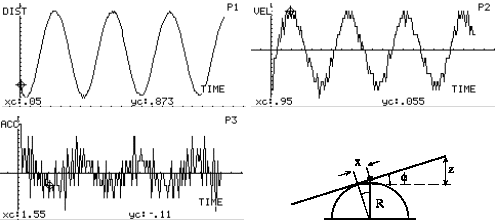See-Saw
with double pivot

The restoring torque is due
to gravity and to pivot reaction. Torque depends on the oscillation amplitude
F
because the effective component of the gravity force is not constant:
 The lever arm of the torque is
constant, and for small oscillations (and d<<L)
The lever arm of the torque is
constant, and for small oscillations (and d<<L)

The vertical component of the
acceleration of the bar ends is

The center of mass "rebounces"
like
in the Galileo Oscillator.

-
The plots x(t), v(t), a(t) vs.
time show the same behavior as in the Galileo Oscillator.
-
Using the small angle approximation
the predicted acceleration of the bar end is constant a=3gd/L
-
The period T may be measured and
plotted versus the square root of the oscillation amplitude z showing the
agreement with the predicted slope

-
By repeating the experiment with
heavy masses at the bar ends (well simulating the motion of a real see-saw)
it can be shown that acceleration changes into a=gd/L, 1/3 of the value
measured for the unloaded bar.
See-Saw
with round pivot

The restoring torque is due
to gravity and to pivot reaction.
Torque depends on the oscillation
amplitude f
The effective component of
the gravity force is not constant:

Here also the lever arm of
the torque is not constant:

While the momentum of inertia
is
nearly constant:

For small oscillations and
d<<L

This equation is the same as
the equation of a pendulum (for small oscillations) with reduced
length l=L2/12R.
In the same approximation the
motion is harmonic.
(The same analysis may be applied
to the motion of a rocking-chair)

-
The plots x(t), v(t), a(t) vs.
time show a different behavior from that of the see-saw with double pivot.
-
Now the period is independent
of the amplitude: the motion here is harmonic.
-
The teacher may guide the students
to calculate the torque and the moment of inertia, suggesting suitable
approximations in order to find the theoretical relationship between angular
acceleration a
and tilt angle f:
a=—12gR/L2f:
that is the classic pendulum equation.
-
Also here the oscillation measured
with a bar loaded at the ends shows an angular accelerationa=—4gR/L2f,
reduced of a factor 1/3 with respect to the unloaded bar.
CONTINUE
...


![]()
![]()


![]()
![]()
![]()
![]()
